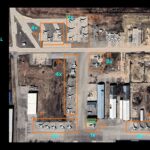On 22 November 2020, U.S. Secretary of State Mike Pompeo, the Saudi Crown Prince Mohammed Bin Salman (MBS), and Israeli Prime-Minister Netanyahu met in Neom (Kingdom of Saudi Arabia). The meeting was the first known official or semi-official encounter between Israel and Saudi Arabia and came at a critical time for the Middle East.
NETANYAHU’S SECRET VISIT
Although the Israeli presence was a secret, the Prime Minister’s Gulfstream IV private jet (T7CPX) was spotted on flight trackers. ADS-B data shows the flight path of T7CPX from Tel Aviv-Yafo to Neom, where the plane remained grounded for two hours. The aircraft returned to Israel around 22:05 UTC.

Flight tracking data confirms that Israeli PM Netanyahu’s private jet travelled to Neom on the evening of November 22 (T-Intelligence)
Netanyahu’s presence in Neom has since become an open secret, as multiple sources from the cabinet confirmed the story for Israeli news outlets. Israeli media also reported that Mossad chief Yossi Cohen joined PM Netanyahu for the meeting in Neom.
The main point on the agenda was likely the normalization of Israeli-Saudi relations. Secretary Mike Pompeo has pursued MBS to follow the example of his neighbors, the United Arab Emirates (UAE) and Bahrain, to establish formal ties with Israel. However, Riyadh has publically stated that an Israeli-Palestinian peace agreement is a precondition for a Saudi-Israeli deal.
GOING AFTER “PROJECT AMAD?”
There is increasing speculation that the parties also discussed the Iranian threat.
After years of backchanneling, Saudi Arabia and Israel may be negotiating the possibility of direct action against Iran’s nuclear program (Iranian codename Project “Amad”). The Israelis are interested in using Saudi airspace to refuel and return after striking the nuclear facilities in central and south Iran.
Israel may have already discussed or will discuss similar arrangements with Bahrain and the United Arab Emirates.
#BREAKING: Last night, #Israel‘s PM #Netanyahu & head of #Mossad traveled to #SaudiArabia where they met Mohammed bin Salman & #US Secretary #Pompeo to discuss about an incoming peace deal & also #IsraelAirForce‘s airstrikes at #Iran‘s Nuclear sites through #SaudiArabia airspace! pic.twitter.com/aQpPNmUDln
— Babak Taghvaee – Μπάπακ Τακβαίε – بابک تقوایی (@BabakTaghvaee) November 23, 2020
A potential Israeli campaign against Iran’s nuclear program would require more than 20 fighter aircraft, including F-35I stealth fighters, and many other logistical support assets like aerial tankers. These assets need to be forward deployed and their flight paths carefully coordinated to ensure the operation’s success and a safe return for the Israeli pilots. Additionally, the operation would likely require special operations forces (SOFs), who would insert from nearby states.
From Israel’s perspective, the issue of military action against Iran has become more pressing after President Trump’s electoral loss. President-elect Biden will likely have a softer stance on Iran. Biden has already promised to re-join the nuclear deal with Iran if Tehran promises strict compliance. At the moment, these plans are nevertheless speculation. There are no troop movements or logistical preparations that suggest an imminent attack against Iran. Israel and Saudi Arabia are likely trying to establish common ground should the military option be on the table in the future.
MISSILE STRIKE ON JEDDAH
Hours after the Neom meeting ended, the Yemeni Houthi militia launched a cruise missile strike on an Aramco petrochemical plant in Jeddah. Geolocation of social media material confirms the event and location.

Geolocation confirms authenticity and location of an Instagram video that claims to show a fire at the Aramco facility in Jeddah (T-Intelligence)
The Yemeni Houthi militia claims to have debuted the Quds-2, one of the many missiles Iran is secretly developing for its proxies. Quds-2 is believed to be a spin-off of Iran’s Soumar or Ya-Ali missiles.
Launched from an undisclosed location in northern Yemen, the Quds-2 missile traveled 640 km (400 miles) to Jeddah, the militants claim.
While the Houthi already possess ballistic missiles (BM) that can strike targets 1,000 km away, the increased range of the militants’ low-observable (LO) munition is concerning. LO munition like cruise missiles and so-called “suicide drones” can bypass the Saudi PAC-2 air defenses designed to counter BMs.
Battle damage assessment shows minimal damage at the Aramco plant in Jeddah. One crude oil storage tank was disabled, and the blast scarred a second tank.

Battle Damage Assessment shows minimal damage on Aramco facility in Jeddah (imagery: Planet Labs, Inc.; assessment: T-Intelligence)
The attack was a clear message from Iran. It serves as a reminder of Iran’s massive missile stockpile and proxy network in the Middle East.
by HARM
Editing by Gecko
Our findings were first published as a Facebook post on 23 November 2020.
This article was produced using Open-Source Intelligence (OSINT). Learn more about OSINT here.
Founder of T-Intelligence. OSINT analyst & instructor, with experience in defense intelligence (private sector), armed conflicts, and geopolitical flashpoints.







